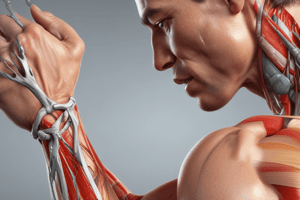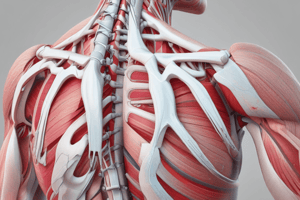Podcast
Questions and Answers
What is a key characteristic of a large/full-thickness rotator cuff tear?
What is a key characteristic of a large/full-thickness rotator cuff tear?
- Painful arc with full passive range of movement
- Loss of active shoulder flexion/abduction improving in 2-6 weeks
- Gradual onset of weakness and pain
- Sudden onset of weakness and superolateral shoulder pain after trauma (correct)
Which cluster of orthopedic tests is recommended for detecting traumatic full-thickness rotator cuff tears?
Which cluster of orthopedic tests is recommended for detecting traumatic full-thickness rotator cuff tears?
- Painful arc, drop arm test, bear hug
- Weakness in ER, drop arm test, painful arc (correct)
- Drop arm test, lift off, painful arc
- Belly press, lift off, bear hug
What may help develop the hypothesis of a full-thickness supraspinatus/infraspinatus tear during examination?
What may help develop the hypothesis of a full-thickness supraspinatus/infraspinatus tear during examination?
- Belly press and bear hug tests
- History of shoulder dislocation
- Night pain, age over 60, and positive rotator cuff testing (correct)
- Young age and history of repetitive strain injury
What characteristic may partially differentiate a subscapularis tear from other rotator cuff tears?
What characteristic may partially differentiate a subscapularis tear from other rotator cuff tears?
What is a common outcome for most partial thickness rotator cuff tears?
What is a common outcome for most partial thickness rotator cuff tears?
When should a referral be considered for partial thickness rotator cuff tears?
When should a referral be considered for partial thickness rotator cuff tears?




